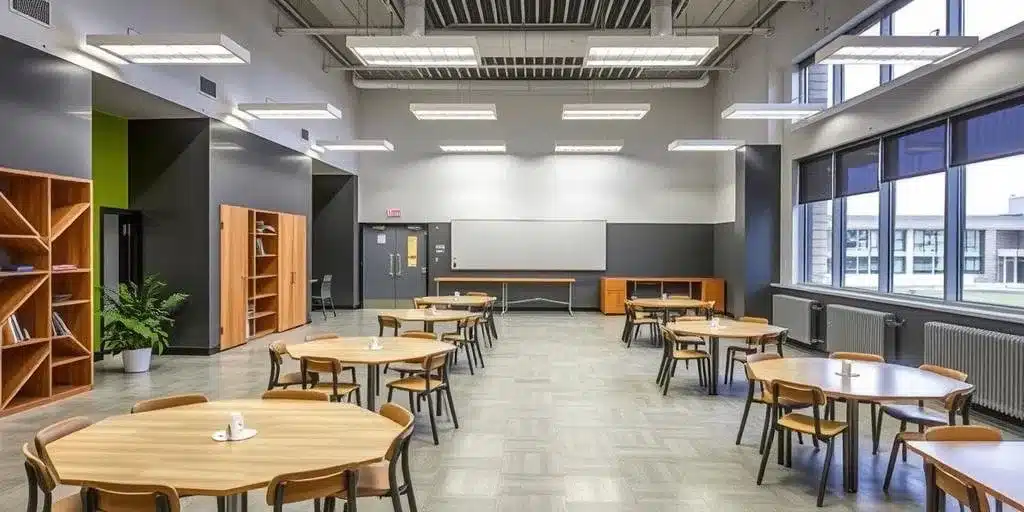Table of Contents
First step to achieve educational success is to create an environment conducive to learning. And any school furniture needs to look and function this way in order to create such a good environment. Stylish and functional furniture can greatly improve the look and functionality of learning spaces, creating an environment where students and learners flourish.
Enhancing Comfort and Focus
Both students and their engagement need comfort. Furnishing oriented in ergonomics enables one to maintain a good posture, minimizing fatigue with long hours of studying. Also, desks and chairs are adjustable to accommodate different heights and preferences among students, ensuring comfort and focus. When students are comfortable in their surroundings, they can focus and hence perform better academically. Using Marco School Furnishings can help.
Promoting Flexibility and Collaboration
Definable room environments are a fundamental aspect of today’s classroom spaces. Furniture that can be reconfigured easily promotes different styles of teaching and group activities. Desks and reconfigurable tables support collaboration, providing an opportunity for students to engage in projects and discussions together. This adaptability fosters creativity and also helps in communication skills, which prepare students for many future complications.
Optimizing Space Utilization
Through the use of space, it is important in education. Space-saving furniture: need of the hour. For example, items that can be stacked, like chairs and tables that can be folded and put away. Their flexibility keeps the classrooms neat and spacious enough for everyone to move around and engage. An organized space is essential for a good learning environment.
Incorporating Technology Integration
In this fangled age, education cannot go without the use of technology. Furniture, in consideration of this, accommodates electronics. Desks with integrated charging ports and built-in cable management allow laptops and tablets to plug in. The design helps not only to keep devices charged but also to keep them looking clean. Accessibility to digital resources is pretty easy for students as it enhances their learning experience.
Supporting Diverse Learning Needs
Requirements of each student are different. Different students can have very different requirements in terms of space and size, and inclusive furnishing allows them to gear up correctly for success. Different users have different preferences and abilities, which is why height-adjustable tables and sensory seating options can help. When schools take these differences into account, they allow for an environment where any learner can be successful.
Boosting Aesthetic Appeal
A learning space is visually appealing, and this reflects on the motivation of each student. Contemporary materials paired with pops of color and angular shapes make it feel approachable. Depending on the intention behind it, schools can utilise colour schemes to energise or to calm students. An appealing setting interests and excites learning and makes school a pleasant place to be.
Encouraging Sustainable Practices
Schools are the microcosm of society, and sustainability is of growing importance within these institutions. Furniture that is made of recycled or safer materials showcases an effort to maintain the environment. Opting for long-lasting, well-made items limits the need for replacements, which helps to cut down on waste. Sustainable schools set an example for students and teach them how to care for the Earth.
Improving Staff Workspaces
Well-designed furniture also helps educators. When teachers feel at ease and can use their space with ease, they can spend their time preparing lessons and grading. They enable them to be healthy and productive by using adjustable desks and ergonomic chairs. Providing nice staffroom spaces encourages and creates a supportive culture, which increases morale and job satisfaction. Happy, empowered teachers bring the entire school down with their positive energy.
Investing in Long-Term Benefits
Although modern furniture comes with an initial cost, it is worth the money in the long haul. It could be expensive replacing items down the line, and likely (depending on what it is) you will have to replace it, whereas durable furniture cuts this cost over time. The school benefits from high student outcomes and increased teacher satisfaction. In choosing to emphasise quality and function, schools create spaces that not only sustain growth today, but for years to come.
Conclusion
When a school is furnished with contemporary items that are functional, that is a key decision that influences both the studies of the student and the lessons of the teacher. Schools that value and promote comfort, flexibility, and need can provide spaces and environments for all to thrive. Quality furniture for educational use is more than about looks: it is about creating an environment of learning by designing spaces which promote growth, development, and collaboration in classrooms.


